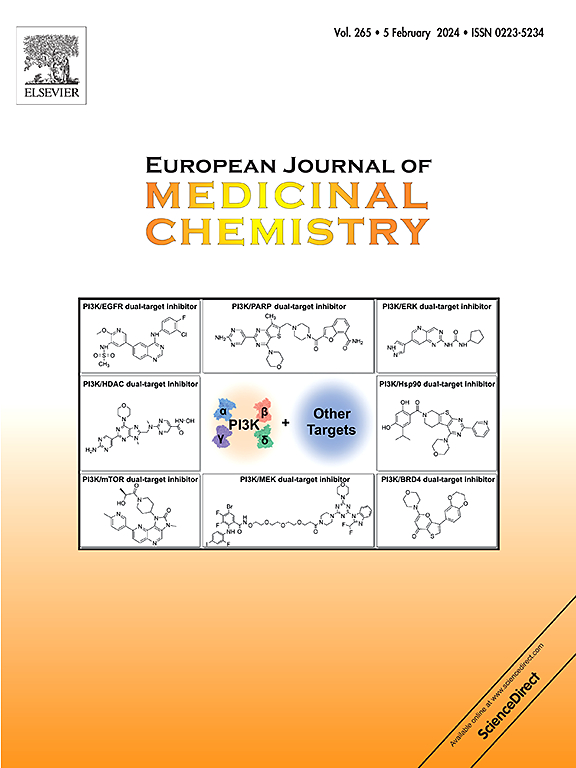基于二苯并[b,e]azepin-6(6H)- 1支架的PEX5-PEX14蛋白-蛋白相互作用抑制剂的量子力学驱动构效关系研究
IF 6
2区 医学
Q1 CHEMISTRY, MEDICINAL
引用次数: 0
摘要
靶向蛋白-蛋白相互作用(PPIs)是一种很有前途的药物开发策略。然而,尽管该领域取得了相当大的进展,但用小分子靶向PPIs仍然具有挑战性,需要在抑制剂设计和随后的构效关系(SAR)研究中采用新的策略。我们最近确定了PEX5-PEX14 PPI作为治疗与锥虫感染相关疾病的新靶点,并利用基于结构的药物发现(SBDD)发现了针对PEX14的小分子抑制剂。目前的研究表明,将SBDD与量子力学(QM)能量分解和反卷积分析(EDDA)相结合,可以深入了解新开发的PPI抑制剂类中的SAR。我们获得了多种二苯并[b,e]azepin-6(6H)- 1 PEX14抑制剂,这是通过重新设计先前化合物系之一的中心支架和后续修饰而产生的。多样化策略产生了通过多组分反应(mcr)获得的化合物,其中Kabachnik-Fields反应产物是迄今为止获得的最有效的三环PEX5-PEX14 PPI抑制剂。总的来说,用生物物理分析测量的化合物的活性与qm衍生的化合物结合能一致。因此,使用先进的计算方法,我们的结果为化合物针对PPI目标的SAR合理化铺平了另一种途径。本文章由计算机程序翻译,如有差异,请以英文原文为准。
![Quantum Mechanics-Driven Structure-Activity Relationship Study of PEX5-PEX14 Protein-Protein Interaction Inhibitors Based On a Dibenzo[b,e]azepin-6(6H)-one Scaffold](https://img.booksci.cn/booksciimg/2025-7/2025071910844539209511.png)
Quantum Mechanics-Driven Structure-Activity Relationship Study of PEX5-PEX14 Protein-Protein Interaction Inhibitors Based On a Dibenzo[b,e]azepin-6(6H)-one Scaffold
Targeting protein-protein interactions (PPIs) is a promising strategy in drug development. However, despite the considerable progress in the field, targeting PPIs with small molecules remains challenging, requiring novel strategies in inhibitor design and subsequent structure-activity relationship (SAR) studies. We have recently identified the PEX5-PEX14 PPI as a novel therapeutic target against diseases related to Trypanosoma infections and discovered small-molecule inhibitors against PEX14 using structure-based drug discovery (SBDD). The current study demonstrates that combining SBDD with quantum mechanical (QM) energy decomposition and deconvolution analysis (EDDA) provides an in-depth understanding of SAR in the newly developed PPI inhibitors class. We obtained diverse dibenzo[b,e]azepin-6(6H)-one PEX14 inhibitors, which resulted from redesigning the central scaffold of one of the previous compound lines and follow-up modifications. The diversification strategy yielded compounds obtained by multicomponent reactions (MCRs), from which the Kabachnik-Fields reaction products were the most potent tricyclic PEX5-PEX14 PPI inhibitors obtained so far. Overall, the activities of the compounds measured with biophysical assays aligned with the QM-derived compound binding energies. Hence, using an advanced computational approach, our results pave an alternative way for SAR rationalization of compounds against PPI targets.
求助全文
通过发布文献求助,成功后即可免费获取论文全文。
去求助
来源期刊
CiteScore
11.70
自引率
9.00%
发文量
863
审稿时长
29 days
期刊介绍:
The European Journal of Medicinal Chemistry is a global journal that publishes studies on all aspects of medicinal chemistry. It provides a medium for publication of original papers and also welcomes critical review papers.
A typical paper would report on the organic synthesis, characterization and pharmacological evaluation of compounds. Other topics of interest are drug design, QSAR, molecular modeling, drug-receptor interactions, molecular aspects of drug metabolism, prodrug synthesis and drug targeting. The journal expects manuscripts to present the rational for a study, provide insight into the design of compounds or understanding of mechanism, or clarify the targets.

 求助内容:
求助内容: 应助结果提醒方式:
应助结果提醒方式:


